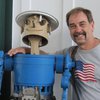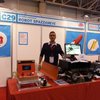Projects I Like & Follow
Share this profile
ShareBits
Become a Hackaday.io Member
Create an account to leave a comment. Already have an account? Log In.
Hi @alpha le ciel and thanks for liking my universal battery protection circuit board!
Thanks for liking Bobble-Bot. Let me know if you have any questions about the project. You can find more info here : http://so.engineering/#bobble-bot-hl
Thank you for liking my Haptic Clock! I think your idea of using Bamboo as a building material for wind turbines is unique and advantageous to what you are trying to accomplish, and could help with deployment of the technology to remote areas. Best of luck!
Hello Alpha, thanks for liking the #Kobold retro TTL computer !
Good morning and thank you for following #Featured Projects list.
Good morning and thank you for liking #My first Fursuit - Yes I am a Furry and #Light Logic :-D
Thank you for the like of #MPRT - Modified planetary robotics transmission . I hope to get to build something interesting with this, but I'm not there yet. Feel free to steal at will and make it something more... :)
Thankyou for the follow, be sure to skull anything you like :)
Thank you for liking my project, http://trendeca.com/
Cheers, Sean
Hi Alpha le Ciel, thank you for liking the One Transistor FlipFlop, https://hackaday.io/project/112126-one-transistor-flipflop !
Hey alpha-LC, thanks for the like and good luck with the prize!
 Reginald Sourn
Reginald Sourn Steve Carlson
Steve Carlson MasterOfNull
MasterOfNull milad
milad John Loeffler
John Loeffler Rohan Menon
Rohan Menon Erik Knutsson
Erik Knutsson Max Olender
Max Olender Fabian
Fabian WalkerDev
WalkerDev Guillermo Perez Guillen
Guillermo Perez Guillen Ayush Kumar Lall
Ayush Kumar Lall Frank Buss
Frank Buss Lutetium
Lutetium davedarko
davedarko
















@alpha le ciel Thank you for liking my low-cost Time of flight gravimeter arrays project. I am working on a new one just now to both track the sun and moon using their tidal gravitational signal. But also to use the same sensor with purpose-built gravitational signals in a lab or using nearby things (people, cars, trucks, trains, planes, ocean waves, atmospheric waves and current, ocean currents. [The theory on such things has been worked out long ago. But it required significant advances in 3D measurement in real time to give the mass and density distributions so that the resulting gravitational potential and its gradients (acceleration fields) can be calculated precisely enough to predict the signals at detector arrays.] to locally calibrate the detectors. Cavendish and Foucault pendulum on steroids with Raspberry Pi and Jetson Nanos and Pi Q cameras. Oh my.
I tried to send you a private message but the messaging system is super slow and unreliable. Not sure why, but I will leave you this note, knowing most people never seem to read comments. I have been looking for people to help with building some lasers, cameras and computers for tracking simple things - pendulum, vibrating cantilever, surface of water, particles in water and liquids, reflections from small objects (specular reflection+), flames and turbulence. I am getting old enough I simply cannot learn fast enough to do all the things I want to do. I never really understood how these projects are supposed to work here. With no real background on anyone, how can you guess backgrounds and skills? There seems to be no way to donate to people with good project ideas. These project descriptions are so chaotic and incomplete (many, not all). And all of it is hard for someone who cannot see that well any more.
I did not finish my thought above. Measure local masses where the mass and composition are known precisely, calibrate the detector using the sun and moon tidal signal. Then use that to trace out why the "Big G" experiments (experiments to measure the gravitational constant G) vary so much - from place to place and time to time. I am pretty sure I know why, but I trust measurement and large groups of people hammering on a model and related data streams -- to understand it deeply.
It needs to be inexpensive because gravity affects everyone and no one should be locked out of knowledge and participation because things seem too hard to find, or afford, or share. I really would like to change the way Hackaday IO forms groups and communicates. So close, but missing simple things.
Richard Collins, Director, The Internet Foundation